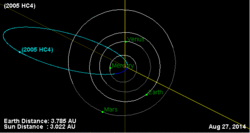Astronomy:2005 HC4
From HandWiki
Short description: Asteroid
 | |
| Discovery[1] | |
|---|---|
| Discovered by | LONEOS |
| Discovery date | 30 April 2005 |
| Designations | |
| Minor planet category |
|
| Orbital characteristics[2] | |
| Epoch 3 May 2005 (JD 2453493.5) | |
| Uncertainty parameter 9 | |
| |{{{apsis}}}|helion}} | 3.5707 astronomical unit|AU (534.17 Gm) |
| |{{{apsis}}}|helion}} | 0.070657 AU (10.5701 Gm) |
| 1.8207 AU (272.37 Gm) | |
| Eccentricity | 0.96119 |
| Orbital period | 2.46 yr (897.30 d) |
| Mean anomaly | 341.42° |
| Mean motion | 0° 24m 4.32s /day |
| Inclination | 8.3967° |
| Longitude of ascending node | 63.790° |
| 309.01° | |
| Earth MOID | 0.0615074 AU (9.20138 Gm) |
| Jupiter MOID | 1.92798 AU (288.422 Gm) |
| Physical characteristics | |
| Dimensions | 210–480 m[3] |
| Absolute magnitude (H) | 20.7 |
2005 HC4 is the asteroid with the smallest known perihelion of any known object orbiting the Sun (except sungrazing comets). Its extreme orbital eccentricity brings it to within 0.071 AU of the Sun (23% of Mercury's perihelion) and takes it as far as 3.562 AU from the Sun (well beyond the orbit of Mars). Due to its very small perihelion and comparably large aphelion, 2005 HC4 achieves the fastest speed of any known asteroid bound to the Solar System with a velocity of 157 km/s (565,000 km/h; 351,000 mi/h) at perihelion[4] (there are comets, however, which obtain much higher speeds).
See also
- List of Mercury-crossing minor planets
- List of Venus-crossing minor planets
- Apollo asteroids
- List of Mars-crossing minor planets
References
- ↑ "MPEC 2005-J02 : 2005 HC4". IAU Minor Planet Center. 2005-05-01. http://www.minorplanetcenter.org/mpec/K05/K05J02.html. Retrieved 2014-03-05. (K05H04C)
- ↑ "JPL Small-Body Database Browser: (2005 HC4)". Jet Propulsion Laboratory. http://ssd.jpl.nasa.gov/sbdb.cgi?sstr=2005%20HC4. Retrieved 30 March 2016.
- ↑ "NEODyS 2005 HC4". Near Earth Objects – Dynamic Site. https://newton.spacedys.com/neodys/index.php?pc=1.1.9&n=2005HC4. Retrieved 2014-03-07.
- ↑ As calculated with the vis-viva-equation : [math]\displaystyle{ v^2 = GM \left({ 2 \over r} - {1 \over a}\right) }[/math]
where:
- v is the relative speed of the two bodies
- r is the distance between the two bodies
- a is the semi-major axis (a > 0 for ellipses, a = ∞ or 1/a = 0 for parabolas, and a < 0 for hyperbolas)
- G is the gravitational constant
- M is the mass of the central body
External links
- 2005 HC4 at NeoDyS-2, Near Earth Objects—Dynamic Site
- Ephemeris · Obs prediction · Orbital info · MOID · Proper elements · Obs info · Close · Physical info · NEOCC
- 2005 HC4 at ESA–space situational awareness
- 2005 HC4 at the JPL Small-Body Database
 |

